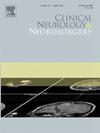在治疗慢性硬膜下血肿时单独使用脑膜中动脉栓塞术与联合传统手术的比较:系统回顾和荟萃分析
IF 1.8
4区 医学
Q3 CLINICAL NEUROLOGY
引用次数: 0
摘要
方法 在PubMed、Google Scholar、Scopus和CINAHL上进行系统性文献检索,然后进行荟萃分析,比较复发率、手术抢救、死亡率、院内并发症和住院时间。使用随机效应模型对平均差和风险比进行汇总,并使用Cochrane RevMan 5.4.1软件进行亚组分析。结果共分析了23项研究,包括302168名患者(62.5%为男性,37.5%为女性),大多数研究发表于2017年至2024年之间。在这些患者中,299195 人(99.0%)接受了传统手术治疗,3113 人接受了 MMAE 治疗。与传统手术相比,MMAE 患者的复发率明显降低,复发风险降低了 0.35 倍(95 % CI:0.24-0.51,p<0.01)。然而,辅助 MMAE 与较长的住院时间相关(SMD:2.61 [95 % CI:2.46-2.76],p<0.01),尽管与辅助 MMAE 相比,单纯 MMAE 的住院时间较短。此外,MMAE 的手术抢救风险较低(0.29 倍,p<0.01)。结论由于复发和手术抢救风险较低,MMAE单独或与传统手术辅助治疗慢性硬膜下血肿是一种很有前途的替代传统手术的方法。这种新方法的疗效还需要进一步的前瞻性研究。本文章由计算机程序翻译,如有差异,请以英文原文为准。
Middle meningeal artery embolization alone versus combined with conventional surgery in the management of chronic subdural hematoma: A systematic review and meta-analysis
Objective
To compare outcomes of middle meningeal artery embolization (MMAE) alone versus combined with conventional surgery in the management of chronic subdural hematoma (cSDH).
Methods
A systematic literature search was performed on PubMed, Google Scholar, Scopus, and CINAHL, followed by a meta-analysis comparing recurrence rates, surgical rescue, mortality, in-hospital complications, and length of hospital stay was conducted. Mean differences and risk ratios were pooled using a random effects model, with subgroup analysis performed using Cochrane RevMan 5.4.1 software.
Results
A total of 23 studies including 302,168 patients (62.5 % male, 37.5 % female) were analyzed, with most studies published between 2017 and 2024. Among these patients, 299,195 (99.0 %) were treated with conventional surgery, whereas 3113 underwent MMAE. MMAE patients showed a significantly lower recurrence rate compared to conventional surgery, with a 0.35 times lower risk of recurrence (95 % CI: 0.24–0.51, p<0.01). However, adjunctive MMAE was associated with a longer hospital stay (SMD: 2.61 [95 % CI: 2.46–2.76], p<0.01), though MMAE alone had a shorter stay compared to adjunctive MMAE. Additionally, MMAE demonstrated a lower risk of surgical rescue (0.29 times, p<0.01). While no significant difference was found in-hospital complications (RR: 1.01, 95 % CI 0.90–1.14, p=0.84) and mortality rates (RR: 0.88, 95 % CI 0.69–1.14, p=0.34).
Conclusion
MMAE stand-alone or adjunctive with conventional surgery presents a promising alternative to conventional surgery alone for chronic subdural hematomas due to lower recurrence and surgical rescue risk. Further prospective studies are needed to study the efficacy of this new approach.
求助全文
通过发布文献求助,成功后即可免费获取论文全文。
去求助
来源期刊

Clinical Neurology and Neurosurgery
医学-临床神经学
CiteScore
3.70
自引率
5.30%
发文量
358
审稿时长
46 days
期刊介绍:
Clinical Neurology and Neurosurgery is devoted to publishing papers and reports on the clinical aspects of neurology and neurosurgery. It is an international forum for papers of high scientific standard that are of interest to Neurologists and Neurosurgeons world-wide.
 求助内容:
求助内容: 应助结果提醒方式:
应助结果提醒方式:


